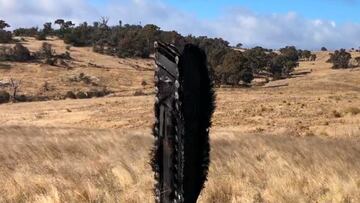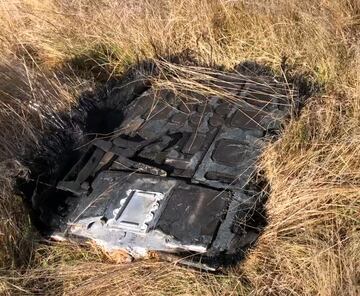What is the nine-foot-tall object that landed on an Australian farm?
Mick Miners, a farmer in New South Wales, was puzzled to find a large, black object sticking out of the ground on his land.

At the end of July, Australian farmer Mick Miners was taking his usual morning drive surveying his 5000-acre property when he spotted something unusual. There, in a remote part of the grassland was a large, jet-black object sticking out of the ground. At first sight, he thought it might be a burned-out tree or perhaps a piece of old machinery. “I wasn’t quite sure what to think about it all,” Miners told local media. “I had a bit of a look around and it made me wonder what was going on”.
Related news
At the same time, on the adjacent field, his neighbour Jock Wallace had also stumbled across a large piece of charred debris, a slab of blackened metal which had appeared from nowhere on his sheep farm, leaving him equally as mystified. On closer inspection, the larger chunk of metal had insulation panelling and scorching marks. Miners contacted the Civil Aviation Safety Authority (CASA) but after explaining about the mysterious object was advised to directly get in contact with NASA.

In the end, the mystery was solved by Dr Brad Tucker, astrophysicist and cosmologist at Australian National University. Tucker identified the object as a piece of space junk which had been jettisoned in outer space, and came hurtling back to earth crash landing on Mick Miners’ farm. The charred surface was caused as it re-entered the earth’s atmosphere at high speed.
The nine-foot-tall object was likely part of the fuselage of the SpaceX Dragon capsule launched from NASA’s Kennedy Space Center in Florida in November last year. After doing some research Dr Tucker confirmed that the debris is from the SpaceX mission. On consulting the tracking data log, Tucker was able to pinpoint the exact time and location coordinates of the debris which re-entered the Earth’s atmosphere at 7 a.m. on 9 July. The other, smaller pieces of debris found nearby in Jock Wallace’s field were also discarded parts of the SpaceX Dragon capsule.
Over 27,000 pieces of orbital debris larger than 10 centimeters are currently being tracked by the Department of Defense’s global Space Surveillance Network (SSN) sensors. These pieces of space junk, of varying sizes, are in orbit around the Earth, travelling at speeds of up to 17,500 mph. Fortunately, at the moment, the greatest threat this space junk poses is damage caused by collisions with other satellites.
What are the chances of being hit and killed by rogue space junk?
The majority of orbital debris that re-enters the Earth’s atmosphere burns up (ablates) before it reaches solid ground. Only large objects, weighing over 1000 kg (1 ton) are able to partially survive the re-entry process. The chances of a person being hit and injured by falling debris from space are practically negligible - according to NASA, the odds are around 10,000 to 1. Only 30% of the Earth’s surface is covered by land and not all of it is populated so you would have to be extremely unlucky to take a direct hit. Having said that, it has happened. In January 1997, Lottie Williams was talking a walk through in her local park in Tulsa, Arizona when she was struck on the shoulder by a six-inch piece of charred metal debris - believed to be part of a Delta II rocket which had crashed into the Earth’s atmosphere around 30 minutes earlier. To this day it is the only recorded case of a person to have been hit by man-made space debris.





